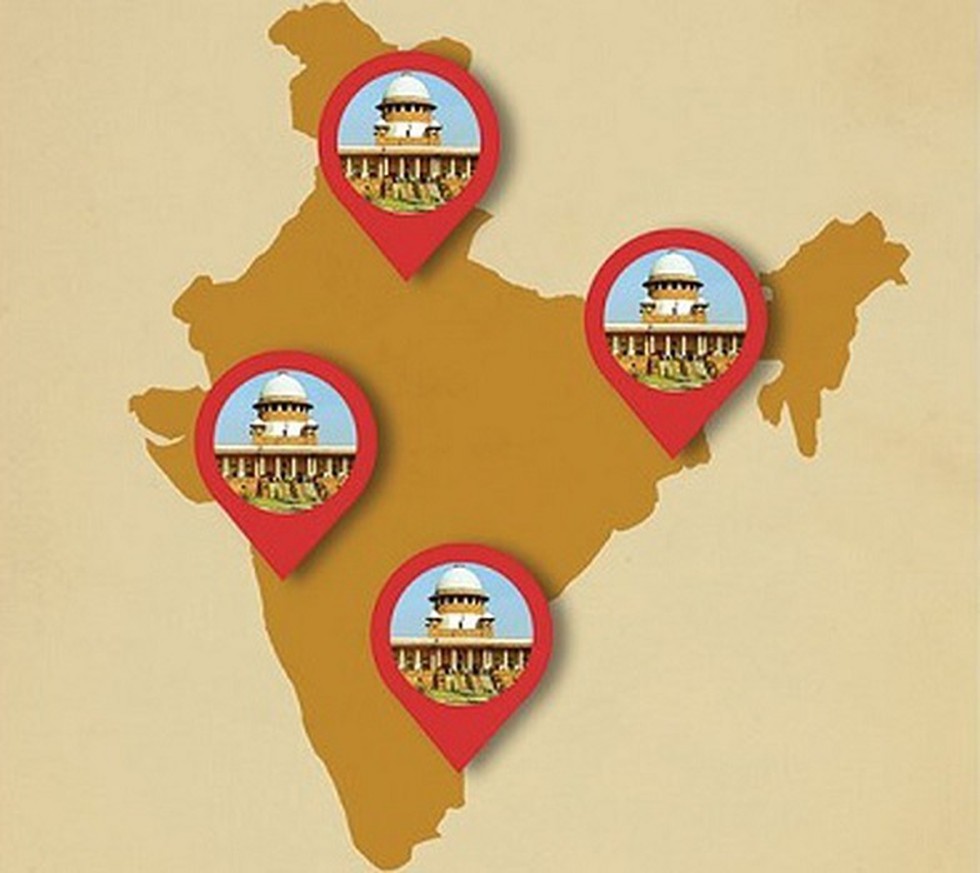From UPSC perspective, the following things are important :
Prelims level: Special Leave Petitions (SLPs)
Mains level: The establishment of regional benches of the Supreme Court in India
Why in the News?
Recently, the Parliamentary Standing Committee on Personnel, Public Grievances, Law and Justice informed the Lok Sabha that the Law Ministry has accepted its recommendation to establish regional benches of the Supreme Court across India.
About the Supreme Court:
About SC Constitution Benches:
|
View of Supreme Court on setting of regional benches
- Recently, CJI D.Y. Chandrachud announced his intent to create Constitution Benches of varied strengths as a permanent feature of the Court.
- The Parliamentary Standing Committee on Personnel, Public Grievances, Law and Justice had earlier noted that the demand for having regional benches of the Supreme Court is about ‘access to justice,’ which is a Fundamental Right under the Constitution. However, the Supreme Court previously has been continuously rejecting the idea.
- During 2019, former Chief Justice Ranjan Gogoi supported the view, but minimal progress was made during his tenure. In contrast, during the 74-day tenure of former Chief Justice U.U. Lalit, 25 Constitution Bench matters were listed before five-judge benches.
Recommendations by the Law Commissions on the setting of regional benches:
- 10th Law Commission (95th Report), 1984: The Supreme Court of India should consist of two Divisions, namely (a) Constitutional Division, and (b) Legal Division”, and that “only matters of Constitutional law may be assigned to the proposed Constitutional Division”.
- 11th Law Commission (125th Report), 1988: Recommended for splitting the (Supreme) Court into two halves deserves to be implemented.
- 18th Law Commission (229th Report), 2009: Recommended that “a Constitution Bench be set up at Delhi to deal with constitutional and other allied issues”, and “four Cassation Benches be set up in the Northern region/zone at Delhi, the Southern region/zone at Chennai/Hyderabad, the Eastern region/zone at Kolkata and the Western region/zone at Mumbai to deal with all appellate work arising out of the orders/judgments of the High Courts of the particular region”.

Significance of Regional Benches in India:
- High Pendency of Cases: In the Supreme Court, a little more than 80,000 cases are currently pending adjudication out of which 60,000 cases are civil. This cannot be alleviated only through usual methods and is highly dependent upon the efforts and efficiency of the Chief Justice.
- Insufficient Case Disposal Rates: In 2023, the Supreme Court witnessed a 31% increase in the disposal of cases compared to 2022.
- However, such a disposal rate is negligible when compared to the total pendency of cases.
- Democratization of Justice: The setting up of regional benches would also lead to greater opportunities and the democratization of the Bar.
- For example, there was lots of opposition when the jurisdiction of the Tis Hazari Court was divided into different district courts. However, 10-15 years down the line, a vibrant District Bar in Saket, Rohini, and Karkardooma can be seen.
- Access to Justice for All: People are reluctant to accept arbitrary actions of the state and its agencies and are increasingly approaching courts of law. The outcome of such cases demands further adjudication by the Supreme Court. Also, it becomes difficult for people living in States far away from Delhi to agitate their cause.
- Importance of Litigant Presence: It is easy to say that the presence of a litigant is not required in appellate forums but the reality is that every litigant wishes to visit his lawyer and witness court proceedings involving his case.
- Boosting Judicial System with More Judges: The establishment of regional benches will increase the number of judges as well as lawyers resulting in a much-needed boost to our judicial system.
Challenges associated with regional benches:
- Status issues:
- Dilution of sacrosanct nature: Critics argue that the idea of setting up regional benches will lead to Balkanization of the Supreme Court and lessen the binding force of the decisions of the Supreme Court.
- Territorial Interference: India being diverse country, have emerging diverse views in judiciary too. Hence, the newly formed regional benches can create conflict of interest by interfering in the territorial jurisdiction of the HCs which may adversely affect our justice system.
- Implementation issues:
- Rectifying the imbalances: Major of the cases filed in Apex court, arise from nearby High Courts in north India, this imbalance cannot be rectified by using this solution.
- Frivolous Petitions: If Justice is that easily accessible considering geographical aspect, there is a possibility of numerous frivolous petitions being filed.
Way Forward:
- Need for Enhancing Judicial Infrastructure: Some broader judicial reforms are needed to address the systemic issues such as judicial backlog, delay in justice delivery, and judicial vacancies, which are crucial for improving the overall functioning of the legal system.
- Explore the use of technology, such as video conferencing and virtual courtrooms, to enhance access to justice and facilitate remote adjudication of cases, especially in remote or underserved areas.
- Need a balanced approach: The debate on regional benches for the Supreme Court involves considerations of accessibility, case management, and judicial efficiency. While proponents see it as vital for access, opponents emphasize potential drawbacks. Striking a balance necessitates thorough evaluation and careful implementation of reforms.
Get an IAS/IPS ranker as your 1: 1 personal mentor for UPSC 2024
